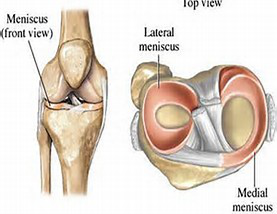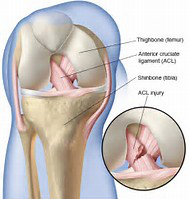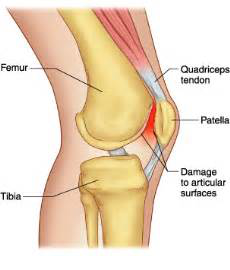
Ligamentous injury and Meniscus injury
A meniscal injury is when there is damage to one or both of the cartilage discs within the knee joint. These cartilages act as shock absorbers within the knee to assist in cushioning ground reaction forces. This injury occurs most commonly when the knee is twisted and may occur in the triad with the anterior cruciate ligament and medical collateral ligament. This often occurs when the patient is changing direction quickly whilst the foot is fixed on the ground or when the knee is hit at a certain angle causing the leg to twist or buckle. The patient will initially report pain in the knee joint which may be accompanied by a tearing sensation. The knee may also swell and some patients will report difficulty walking due to pain. Swelling can be immediate or occur over a period of time. Patients also report the knee feels weak and ‘unstable’, and produces clicking noises, locks or gives way. Unfortunately the menisci in the knee have a poor blood supply meaning they are unable to heal by themselves. This often results in ongoing problems if adequate intervention is not provided. These problems may include persistent knee swelling, clicking, locking and giving way. Surgery or cortisone injection is often provided if other ligaments are also injured along with meniscus. Otherwise the management is conservative meaning only physiotherapy treatment can help you to get back to normal activity. Physiotherapy treatment would involves, soft tissue massage and releases, activity modification, gait retraining and stretching and strengthening exercises.

Anterior Cruciate Ligament (ACL) INJURY
An anterior cruciate ligament or ‘ACL’ injury refers to a tear in one of the ligaments within the knee joint. ACL injuries are one of the most common knee injuries in sporting activities worldwide. The ACL is most commonly injured during a twisting motion where the foot is fixed to the ground. This may happen when landing from a jump, pivoting or decelerating quickly. This injury can also happen during a direct injury to the knee, for example, when another player falls across your knee, bending it in the wrong direction. When the ACL is torn, patients commonly report hearing a “pop”, “crack” or feeling of something moving out then back in. When the ACL is completely torn, patients commonly report extreme pain for a few moments followed by no pain at all. If an injury such as this occurs current activity should be ceased immediately until medical advice has been sought. Following an ACL injury the knee swells significantly within 24 hours of the injury. Unfortunately, an injury to the ACL often results in a prolonged recovery, and is the most common cause of prolonged absence from sport. Surgery is required to repair or ‘reconstruct’ the ACL if there is more than 50% tear of the ligament. During surgery, tissue from either your patellar tendon or hamstring tendon is used to replace or reconstruct the ACL. Following surgery, it will be at least twelve months before you return to full contact sport. This can be prolonged if the is injury to surrounding structures. Other structures commonly injured at the same time include the menisci or medial collateral ligament. Injury to these structures results in prolonged swelling and pain with a slow recovery following surgery. Physiotherapy treatment will involve 3 phases: 1. Reducing swelling and increasing range of motion 2. Improving joint function and stretching/releasing tight muscles 3. Graded strength program for return to normal activity.

Patellofemoral pain Syndrome
Patellofemoral syndrome refers to pain which is reported as being inside the knee by patients. This is also referred to as patellofemoral pain syndrome, chondromalacia and runner’s knee. Patellofemoral syndrome is most commonly caused by overuse of the knee. When the knee is moved, the kneecap (patella) slides up and down within a groove on the end of the thigh bone (femur). Repetition of this movement results in the underneath surface of the patella becomes irritated and painful. This may be associated with swelling. The main sensation that is reported to physiotherapists is pain and a significant number of these patients will also report a feeling that the knee is locked or giving way. The pain is felt behind and around the kneecap. Patellofemoral syndrome is aggravated by walking, running, going downstairs or sitting for a prolonged period with bent knees. Some patients also report grinding noises during the straightening phase of knee movement, intermittent swelling and overall weakness in the knee. Patellofemoral syndrome does not usually produce any long-term effects, as long as it is properly managed. Recovery usually takes a number of weeks to months. During this period you can often keep participating in activity within reason. In rare cases, surgery may be required to improve the biomechanics of the kneecap and to relieve pain. This is only performed after conservative or non-surgical treatment has failed to give relief for an extended period of time. Physiotherapy treatment involves activity modification, soft tissue massage, muscle releases, stretching, taping of the knee cap, muscle retraining and coordination exercises and muscle strengthening.
